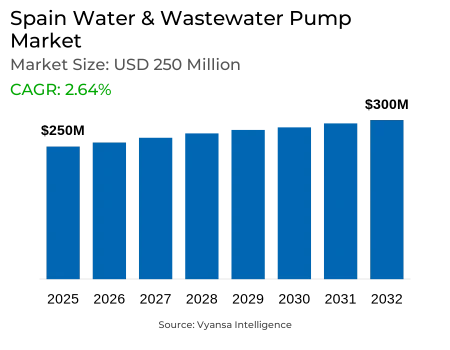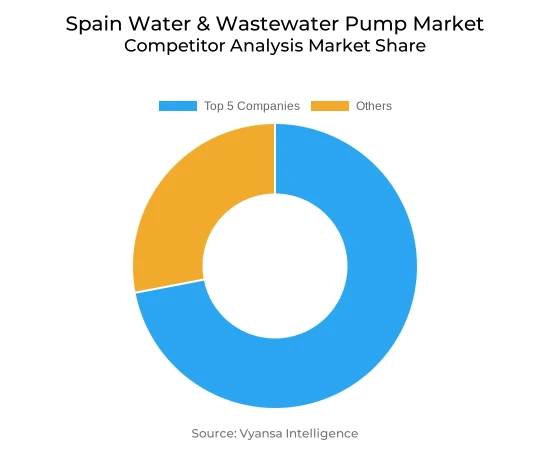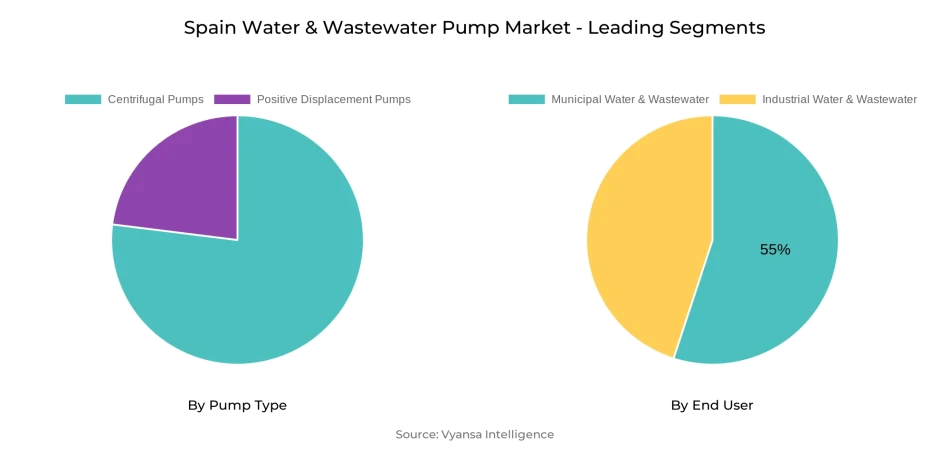
Spain Water & Wastewater Pump Market Report: Trends, Growth and Forecast (2026-2032)
By Pump Type (Centrifugal Pumps (End Suction, Split Case, Vertical (Turbine, Axial Pump, Mixed Flow Pump), Submersible Pump), Positive Displacement Pumps (Progressing Cavity, Diaphragm, Gear Pump, Others)), By Application (Water, Wastewater), By End User (Industrial Water & Wastewater, Municipal Water & Wastewater)
- Energy & Power
- Oct 2025
- VI0490
- 120
-




Spain Water & Wastewater Pump Market Statistics and Insights, 2026
- Market Size Statistics
- Water & Wastewater Pump in Spain is estimated at $ 250 Million.
- The market size is expected to grow to $ 300 Million by 2032.
- Market to register a CAGR of around 2.64% during 2026-32.
- Pump Type Segment
- Centrifugal Pumps continues to dominate the market.
- Competition
- More than 10 companies are actively engaged in producing Water & Wastewater Pump in Spain.
- Top 5 companies acquired the maximum share of the market.
- ITT, IDEX, Dover, Flowserve, Sulzer AG etc., are few of the top companies.
- End User
- Municipal Water & Wastewater grabbed 55% of the market.
Spain Water & Wastewater Pump Market Outlook
Spain's water and wastewater pump market is experiencing consistent growth with investments by the government in renewing old networks and increasing urban supply and sewage treatment networks. The market, worth approximately USD 250 million in 2025, is anticipated to hit USD 300 million in 2032. The growth is triggered by increased demand for energy-efficient pump solutions that enable utilities to meet stringent environmental regulations related to leakage minimization and energy consumption.
Municipal Water & Wastewater dominates the market with approximately 55% of demand. There are over 8,100 service areas that generate a very fragmented municipal landscape, typically restricting technical skills and local budgets. This makes it difficult to standardize pumps and maintain them, leading to greater lifecycle cost. But public–private partnerships are opening up doors for pump manufacturers to win long-term service contracts by providing bundled solutions that integrate high-efficiency pumps, monitoring systems, and maintenance support.
Technologically, Spain is observing fast adoption of intelligent pumping systems with IoT sensors, variable frequency drivers, and cloud-based analysis. Pilot projects indicate energy savings of up to 25%, together with enhanced uptime through predictive maintenance and remote diagnostics. Adoption of digital twin simulations is also picking up, enabling engineers to model pump operation in simulation environments prior to installation, thereby minimizing commissioning risks and project delivery time.
Centrifugal pumps lead the market by pump type, attributed to their low cost and flexibility. Their extensive application in raw water intake, irrigation, and effluent transfer is a testament to their role in Spain's water sustainability strategy. As industrial reuse applications in food, chemical, and pharmaceutical industries increase at a CAGR of 3.82%, pump makers emphasizing rugged, high-performance products are well placed to gain from municipal and industrial demand alike through 2032.

Spain Water & Wastewater Pump Market Growth Driver
Expansion of Water Infrastructure Driving Energy-Efficient Pump Demand
The fast growth of Spain's water infrastructure is driving demand for efficient pumping systems to deal with mounting urban water supply and sewage treatment demands. Governments are investing in updating dilapidated networks, and this has led to a high demand for energy-efficient pump installations on municipal and industrial locations. This momentum is also fueled by strict environmental regulations requiring minimized leakage and minimum energy consumption, which are pressuring utilities to upgrade old systems to new ones with real-time monitoring and smart controls.
At the same time, expanding uses of industrial water reuse—especially in food & beverage and chemical processing—are generating a compelling demand for robust pumps that can withstand variable flow rates and aggressive effluents. Suppliers who can provide reliable performance in these challenging applications stand to benefit from public and private sector investment in sustainable water management.
Spain Water & Wastewater Pump Market Challenge
Fragmented Networks and Wastewater Abrasion Hindering Pump Reliability
Spain’s fragmented municipal network—with over 8,100 distinct service areas—creates logistical hurdles for pump standardization and maintenance. Smaller municipalities often lack technical expertise and budgetary flexibility, resulting in inconsistent pump performance and high lifecycle costs. Coordinating upgrades across such diverse regions complicates procurement and prolongs retrofit timelines.
In addition, the erosive quality of wastewater—loaded with solids and chemicals—speeds up pump components wear, increasing maintenance frequency and unforeseen downtime. Maintaining pump reliability amidst fluctuating wastewater compositions continues to be a crucial hurdle for utilities attempting to sustain service levels and manage operating costs.
Spain Water & Wastewater Pump Market Trend
Rising Adoption of Smart Pumping Systems and Digital Twin Solutions
Spain is experiencing the adoption of smart pumping systems that have IoT sensors, variable frequency drives (VFDs), and cloud-based analytics. The technologies provide real-time performance optimization, predictive maintenance notifications, and remote diagnostics, and they have been contributing to energy savings of as much as 25% in pilot installations. Utilities using these systems experience better uptime and reduced total cost of ownership.
Concurrently, digital twin simulation is increasing in popularity, enabling engineers to simulate pump response to fluctuating load conditions and fluid mixtures prior to field installation. This is minimizing commissioning risk and speeding up project delivery, especially in high-capacity municipal and industrial reuse projects.
Spain Water & Wastewater Pump Market Opportunity
Public–Private Partnerships and Decentralized Treatment Creating New Opportunities
Spain market adoption of public–private partnerships for water plant refurbishment creates an excellent opportunity for pump OEMs to enter into long-term service agreements. Vendors can establish regular revenue streams and enhance customer ties by providing bundled arrangements that include high-efficiency pumps, intelligent monitoring platforms, and maintenance contracts.
Further, the emergence of decentralized water treatment in tourism destinations and agricultural cooperatives is broadening the addressable market to beyond the traditional urban areas. Small size, modular pump packages customized for small communities have the potential to open up new channels of sales and drive Spain's countrywide drive towards water sustainability.
Spain Water & Wastewater Pump Market Segmentation Analysis

By Pump Type
- Centrifugal Pumps
- Positive Displacement Pumps
The Centrifugal Pump segment maintains the largest market share under Pump Type, based on its versatility and cost-effectiveness to handle high flow rates at low to moderate pressures. Such pumps are most commonly applied to raw water intake, secondary effluent transfer, and irrigation uses, where their uncomplicated design and maintenance capabilities provide high operational value.
The manufacturers are making this segment stronger with multi-stage designs for increased head requirements and corrosive and abrasive resistant materials. Advances like magnetically-driven impellers and sophisticated seal technologies further enhance the popularity of centrifugal pumps within Spain's water and wastewater industry.
By End User
- Industrial Water & Wastewater
- Municipal Water & Wastewater
The largest share under End User is in Municipal Water & Wastewater, fueled by utilities' requirement for the upgrade of bulk water transfer and sewerage lift stations. Although large-scale public expenditure persists, the Industrial Water & Wastewater segment is the growth leader with a CAGR of 3.82% as food processing, pharmaceuticals, and chemicals seek efficient solutions for process water recycling and effluent treatment from manufacturers.
Top Companies in Spain Water & Wastewater Pump Market
The top companies operating in the market include ITT, IDEX, Dover, Flowserve, Sulzer AG, KSB, Xylem, Grundfos, Ebara, SPX Flow, etc., are the top players operating in the Spain Water & Wastewater Pump Market.
Frequently Asked Questions
Related Report
1. Market Segmentation
1.1. Research Scope
1.2. Research Methodology
1.3. Definitions and Assumptions
2. Executive Summary
3. Spain Water & Wastewater Pump Market Policies, Regulations, and Standards
4. Spain Water & Wastewater Pump Market Dynamics
4.1. Growth Factors
4.2. Challenges
4.3. Trends
4.4. Opportunities
5. Spain Water & Wastewater Pump Market Statistics, 2022-2032F
5.1. Market Size & Growth Outlook
5.1.1.By Revenues in US$ Million
5.2. Market Segmentation & Growth Outlook
5.2.1.By Pump Type
5.2.1.1. Centrifugal Pumps- Market Insights and Forecast 2022-2032, USD Million
5.2.1.1.1. End Suction- Market Insights and Forecast 2022-2032, USD Million
5.2.1.1.2. Split Case- Market Insights and Forecast 2022-2032, USD Million
5.2.1.1.3. Vertical- Market Insights and Forecast 2022-2032, USD Million
5.2.1.1.3.1. Turbine- Market Insights and Forecast 2022-2032, USD Million
5.2.1.1.3.2. Axial Pump- Market Insights and Forecast 2022-2032, USD Million
5.2.1.1.3.3. Mixed Flow Pump- Market Insights and Forecast 2022-2032, USD Million
5.2.1.1.4. Submersible Pump- Market Insights and Forecast 2022-2032, USD Million
5.2.1.2. Positive Displacement Pumps- Market Insights and Forecast 2022-2032, USD Million
5.2.1.2.1. Progressing Cavity- Market Insights and Forecast 2022-2032, USD Million
5.2.1.2.2. Diaphragm- Market Insights and Forecast 2022-2032, USD Million
5.2.1.2.3. Gear Pump- Market Insights and Forecast 2022-2032, USD Million
5.2.1.2.4. Others- Market Insights and Forecast 2022-2032, USD Million
5.2.2.By Application
5.2.2.1. Water- Market Insights and Forecast 2022-2032, USD Million
5.2.2.2. Wastewater- Market Insights and Forecast 2022-2032, USD Million
5.2.3.By End User
5.2.3.1. Industrial Water & Wastewater- Market Insights and Forecast 2022-2032, USD Million
5.2.3.2. Municipal Water & Wastewater- Market Insights and Forecast 2022-2032, USD Million
5.2.4.By Competitors
5.2.4.1. Competition Characteristics
5.2.4.2. Market Share & Analysis
6. Spain Centrifugal Water & Wastewater Pump Market Statistics, 2020-2030F
6.1. Market Size & Growth Outlook
6.1.1.By Revenues in US$ Million
6.2. Market Segmentation & Growth Outlook
6.2.1.By Pump Type- Market Insights and Forecast 2022-2032, USD Million
6.2.2.By Application- Market Insights and Forecast 2022-2032, USD Million
6.2.3.By End User- Market Insights and Forecast 2022-2032, USD Million
7. Spain Positive Displacement Water & Wastewater Pump Market Statistics, 2020-2030F
7.1. Market Size & Growth Outlook
7.1.1.By Revenues in US$ Million
7.2. Market Segmentation & Growth Outlook
7.2.1.By Pump Type- Market Insights and Forecast 2022-2032, USD Million
7.2.2.By Application- Market Insights and Forecast 2022-2032, USD Million
7.2.3.By End User- Market Insights and Forecast 2022-2032, USD Million
8. Competitive Outlook
8.1. Company Profiles
8.1.1.Flowserve Corporation
8.1.1.1. Business Description
8.1.1.2. Product Portfolio
8.1.1.3. Collaborations & Alliances
8.1.1.4. Recent Developments
8.1.1.5. Financial Details
8.1.1.6. Others
8.1.2.Ebara Corporation
8.1.2.1. Business Description
8.1.2.2. Product Portfolio
8.1.2.3. Collaborations & Alliances
8.1.2.4. Recent Developments
8.1.2.5. Financial Details
8.1.2.6. Others
8.1.3.WILO SE
8.1.3.1. Business Description
8.1.3.2. Product Portfolio
8.1.3.3. Collaborations & Alliances
8.1.3.4. Recent Developments
8.1.3.5. Financial Details
8.1.3.6. Others
8.1.4.Sulzer Limited
8.1.4.1. Business Description
8.1.4.2. Product Portfolio
8.1.4.3. Collaborations & Alliances
8.1.4.4. Recent Developments
8.1.4.5. Financial Details
8.1.4.6. Others
8.1.5.Grundfos Holding A/S
8.1.5.1. Business Description
8.1.5.2. Product Portfolio
8.1.5.3. Collaborations & Alliances
8.1.5.4. Recent Developments
8.1.5.5. Financial Details
8.1.5.6. Others
8.1.6.Xylem Inc.
8.1.6.1. Business Description
8.1.6.2. Product Portfolio
8.1.6.3. Collaborations & Alliances
8.1.6.4. Recent Developments
8.1.6.5. Financial Details
8.1.6.6. Others
8.1.7.KSB SE & Co. KGaA
8.1.7.1. Business Description
8.1.7.2. Product Portfolio
8.1.7.3. Collaborations & Alliances
8.1.7.4. Recent Developments
8.1.7.5. Financial Details
8.1.7.6. Others
8.1.8.Kirloskar Brothers Limited (KBL)
8.1.8.1. Business Description
8.1.8.2. Product Portfolio
8.1.8.3. Collaborations & Alliances
8.1.8.4. Recent Developments
8.1.8.5. Financial Details
8.1.8.6. Others
8.1.9.Franklin Electric
8.1.9.1. Business Description
8.1.9.2. Product Portfolio
8.1.9.3. Collaborations & Alliances
8.1.9.4. Recent Developments
8.1.9.5. Financial Details
8.1.9.6. Others
8.1.10. Pentair PLC
8.1.10.1. Business Description
8.1.10.2. Product Portfolio
8.1.10.3. Collaborations & Alliances
8.1.10.4. Recent Developments
8.1.10.5. Financial Details
8.1.10.6. Others
9. Disclaimer
| Segment | Sub-Segment |
|---|---|
| By Pump Type |
|
| By Application |
|
| By End User |
|
Research Methodology
This study followed a structured approach comprising four key phases to assess the size and scope of the electro-oxidation market. The process began with thorough secondary research to collect data on the target market, related markets, and broader industry context. These findings, along with preliminary assumptions and estimates, were then validated through extensive primary research involving industry experts from across the value chain. To calculate the overall market size, both top-down and bottom-up methodologies were employed. Finally, market segmentation and data triangulation techniques were applied to refine and validate segment-level estimations.
Secondary Research
The secondary research phase involved gathering data from a wide range of credible and published sources. This step helped in identifying industry trends, defining market segmentation, and understanding the market landscape and value chain.
Sources consulted during this phase included:
- Company annual reports, investor presentations, and press releases
- Industry white papers and certified publications
- Trade directories and market-recognized databases
- Articles from authoritative authors and reputable journals
- Gold and silver standard websites
Secondary research was critical in mapping out the industry's value chain and monetary flow, identifying key market segments, understanding regional variations, and tracking significant industry developments.
Other key sources:
- Financial disclosures
- Industry associations and trade bodies
- News outlets and business magazines
- Academic journals and research studies
- Paid industry databases
Primary Research
To validate secondary data and gain deeper market insights, primary research was conducted with key stakeholders across both the supply and demand sides of the market.
On the demand side, participants included decision-makers and influencers from end-user industries—such as CIOs, CTOs, and CSOs—who provided first-hand perspectives on market needs, product usage, and future expectations.
On the supply side, interviews were conducted with manufacturers, industry associations, and institutional participants to gather insights into current offerings, product pipelines, and market challenges.
Primary interviews provided critical inputs such as:
- Market size and revenue data
- Product and service breakdowns
- Market forecasts
- Regional and application-specific trends
Stakeholders consulted included:
- Leading OEM and solution providers
- Channel and distribution partners
- End users across various applications
- Independent consultants and industry specialists
Market Size Estimation and Data Triangulation
- Identifying Key Market Participants (Secondary Research)
- Goal: To identify the major players or companies in the target market. This typically involves using publicly available data sources such as industry reports, market research publications, and financial statements of companies.
- Tools: Reports from firms like Gartner, Forrester, Euromonitor, Statista, IBISWorld, and others. Public financial statements, news articles, and press releases from top market players.
- Extracting Earnings of Key Market Participants
- Goal: To estimate the earnings generated from the product or service being analyzed. This step helps in understanding the revenue potential of each market player in a specific geography.
- Methods: Earnings data can be gathered from:
- Publicly available financial reports (for listed companies).
- Interviews and primary data sources from professionals, such as Directors, VPs, SVPs, etc. This is especially useful for understanding more nuanced, internal data that isn't publicly disclosed.
- Annual reports and investor presentations of key players.
- Data Collation and Development of a Relevant Data Model
- Goal: To collate inputs from both primary and secondary sources into a structured, data-driven model for market estimation. This model will incorporate key market KPIs and any independent variables relevant to the market.
- Key KPIs: These could include:
- Market size, growth rate, and demand drivers.
- Industry-specific metrics like market share, average revenue per customer (ARPC), or average deal size.
- External variables, such as economic growth rates, inflation rates, or commodity prices, that could affect the market.
- Data Modeling: Based on this data, the market forecasts are developed for the next 5 years. A combination of trend analysis, scenario modeling, and statistical regression might be used to generate projections.
- Scenario Analysis
- Goal: To test different assumptions and validate how sensitive the market is to changes in key variables (e.g., market demand, regulatory changes, technological disruptions).
- Types of Scenarios:
- Base Case: Based on current assumptions and historical data.
- Best-Case Scenario: Assuming favorable market conditions, regulatory environments, and technological advancements.
- Worst-Case Scenario: Accounting for adverse factors, such as economic downturns, stricter regulations, or unexpected disruptions.
Partnering With Industry Leaders to Drive Growth
Our mission is to deliver intelligence that matters. By combining data, analysis, and industry expertise, we enable organizations to make smarter, faster, and more impactful decisions. Whether it’s a Fortune 500 company or a high-growth startup, businesses trust us to provide clarity in an ever-evolving marketplace.






